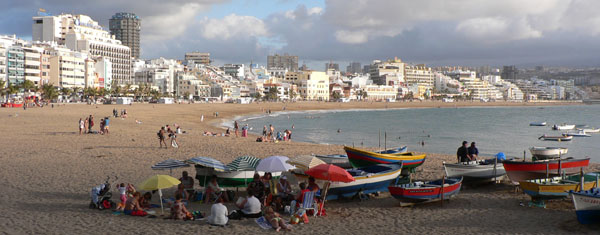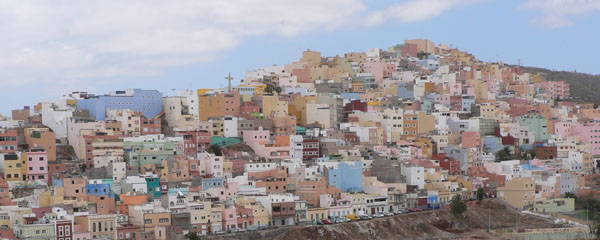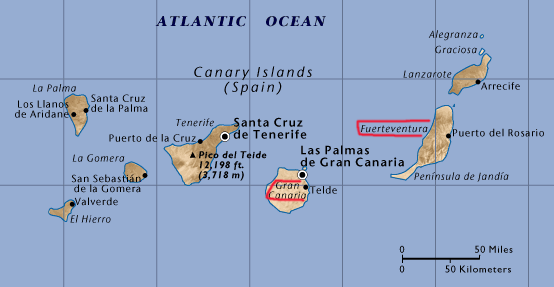Family History in the Canary Islands
(26 May -26 June 2007)
Historia Familiar en las Islas Canarias

Characteristic volcanic cones: Gáldar (Gran Canaria), and Teide 12,198ft (Tenerife)
Típicos conos volcánicos: Gáldar (Gran Canaria), y Teide 3,718m (Tenerife)
Introduction Gladys's family has always known about its roots in the Canary Islands, because her grandmother's parents both emigrated from there to Uruguay, finishing in Chile, some time before 1900. However, which island they came from was not certain; and there was no information about prior generations. But, the name had a mystique, somewhere to visit "one day". The opportunity came about in the following way. Early this year, we received an enquiry at our "British in Southern Patagonia" website, sent by a resident of the Islands, about distant relatives of his who once lived in Chile. We provided the little data available in our files, asking, out of curiosity, how one would begin genealogy research in the Canaries. The response exceeded all expectations, insofar that Pablo and his wife located several church records, sending us photographs of the original pages. What's more, they told us that there were some very old registers available, and that we should definitely find the data we were seeking. With the "missing link" now in hand, it was an easy decision to exchange the cold and damp of the southern autumn and winter for a few weeks in the balmy air of a popular tourist destination. Gladys's mother, as a direct descendant, found this an excellent opportunity to extend a trip that she had already planned to the Balearic Islands. So, plans were made, and the big day came at last. This is where our story begins ... |
Presentación La familia de Gladys sabía de su ascendencia canaria, pues dos de sus antepasados directos, los abuelos de su madre, habían emigrado de allí a Punta Arenas, via Uruguay, a fines del siglo XIX. Sin embargo, no estaba bien claro en qué isla habían nacido, y no existía información sólida sobre las generaciones anteriores a ellos. Pero, como ser descendiente de canarios era un motivo de interés, siempre se hablaba de visitar la tierra ancestral "algún día". Y, la oportunidad se dio. A principios de 2007, recibimos una consulta en nuestro sitio "Los británicos en la Patagonia austral", procedente de alguien de Canarias, cuyo antepasado distante había residido en Chile. Al responder, preguntamos, por saber, cómo se podían hacer investigaciones de genealogía en las Islas. La respuesta fue mucho más allá de lo que imaginábamos: Pablo y su esposa Carmensa ubicaron dos partidas relacionadas a la pareja emigrante y nos enviaron copias. Además, nos informaron que existían registros muy antiguos, y que seguramente tendríamos suerte en encontrar los datos que quisiéramos. Con ese incentivo, y el invierno aproximándose en Chile, fue una decisión fácil dirigirse al otro hemisferio, a gozar de las bondades del clima de Canarias, y realizar nuestras búsquedas. Además, la madre de Gladys, descendiente más directa, planeaba un viaje a Baleares y sería práctico combinarlo con una visita al terruño de sus abuelos: cosa que ella aceptó con mucha ilusión. Así, con grandes esperanzas, partimos a la aventura, y comenzamos a escribir otra "historia de viaje". |

Agaete valley: north-western Gran Canaria
Valle de Agaete: noroeste de Gran Canaria
Genealogical Research We were almost overwhelmed by the wealth of information that is available. For the 7 parishes we examined, records go back as much as 500 years; and, since about 1700, register entries name both parents and grandparents. Add to this the helpful Spanish convention of retaining the surnames of both parents (women don't adopt the husband's surnames, either), and it becomes clear how quickly and confidently the work can proceed. On the downside, not all registers have indexes; or, in earlier times, these have been organized by forename (rather than surname). Margin summaries reflect the same approach, forcing one to scan the handwritten text for pertinent surnames. However, these are minor quibbles, mostly reducing productivity. In practical terms, the experience was quite different from our previous research. Whereas we were able to study British and Chilean sources "at a distance" using the LDS family history centres and the International Genealogical Index (IGI, now available on Internet), the Canary Islands church registers are only accessible "on site". The originals are held by the individual local parishes: to see them, we obtained permission on arrival, from the vicariate in Las Palmas. Opening hours for the parish archives are restricted, varying widely from one place to another. For the investigator on a short timeframe, this can mean quite a lot of travelling, and pressure for "results". In every case, the parish priests were helpful, and understanding of our special needs. |
Investigación genealógica La riqueza archivística de las islas es impresionante. Pudimos examinar registros en siete parroquias diferentes, cuyos libros más antiguos llegan hasta los años 1500. Las búsquedas pueden ser muy fructíferas, debido a tres factores principales: (1) la tradición de especificar tanto el apellido paterno, como el materno, (2) el uso de los apellidos de soltera de las mujeres para todos los eventos, y (3) el sistema (desde 1720 aproximadamente) de nombrar a padres y abuelos en las partidas de bautismo. El grado de seguridad de identificación aumenta gracias a esto. Los problemas que se encuentran son los tradicionales: registros sin índices; registros casi ilegibles; índices ordenados por primer nombre (no por apellido); y, en los tiempos más antiguos, el uso no estándar de apellidos (uso de apellidos maternos, o de los abuelos en una misma familia, o para una misma persona.) Así y todo, es posible lograr progresos notables. Otro aspecto singular de la investigación genealógica en Canarias (y posiblemente, toda España) es el de no contar con microfilms para examinar el material a distancia (como los hechos por la Iglesia Mormona para otras partes del mundo). Por tanto, hay que visitar las parroquias pertinentes, previa autorización por escrito del Obispado de Canarias en Las Palmas (Gran Canaria). Obtenido ese permiso, hay que adaptarse a las horas de Archivo en cada lugar. Estas varían de parroquia a parroquia. Cumplir con estas exigencias, significa a veces viajar bastante y trabajar "a alta velocidad", para maximizar las oportunidades. Los curas de las parroquias que visitamos fueron en todos los casos muy amables y comprensivos con nosotros y nuestras necesidades especiales. |

Fuerteventura: historic church at La Oliva
Iglesia de La Oliva, Isla de Fuerteventura
Other Sources of Information
|
Otras fuentes de información: personas, registro civil, padrones y libros No se debe estar solo haciendo historia familiar: la red de contactos es una de las herramientas más valiosas para avanzar. Nuestro impulso inicial para el viaje resultó de los datos obtenidos por un contacto en Canarias: ahora, nuestros buenos amigos Pablo y Carmensa. En los diversos archivos parroquiales conocimos otros "aficionados" como nosotros, gente local que transcribía índices, textos o buscaba su propia genealogía. Nuestra línea "Quezada" coincidía con una de la señora de un investigador, quien muy gentilmente procedió a darnos una copia de todos sus datos! El registro civil español comenzó después de 1870, un poco tarde para nosotros (además, se requiere la información precisa para solicitar certificados, lo que no siempre teníamos). Donde obtuvimos buenos resultados (S. XIX) fue con los censos o padrones, tanto eclesiásticos como civiles. Las visitas a las bibliotecas también fueron útiles, ya que hay bastante material sobre emigración a América (especialmente Cuba, Venezuela y Uruguay), y ediciones de fuentes municipales, tesis doctorales, etc. Hubiéramos querido tener más tiempo para leer más... |

Las Canteras beach, Las Palmas
Playa de Las Canteras, Las Palmas

Modern housing district, Las Palmas
Urbanización moderna, Las Palmas
Summing Up: A thrilling experience — hospitable, friendly people — good food and wine — impressive scenery — weather that would hard to beat. |
Conclusión: Una experiencia inolvidable — gente amistosa y hospitalaria — buena comida y bebida — paisajes estupendos — un clima de maravilla, y ...todo un mundo de antepasados!! |
BACKGROUND / DATOS ADICIONALES
 |
| Map: based on an original image, copyright of MapQuest.com |
History / Geography Seven volcanic islands off the Atlantic coast of North Africa, the Canaries enjoy a mild climate, tempered by cool ocean currents. The prevailing winds are from the north-east. Rainfall in the eastern section of the archipelago (Fuerteventura and Lanzarote) is low and unreliable, producing semi-desert conditions. Humans have lived here for over two millennia. Spanish interest dates from the 15th century, when the indigenous peoples were dominated by superior European force: a precursor of the process that would occur a century later in the Americas. During the era of sailing ships, the islands were a convenient resupply point for vessels bound for the New World. As well as foodstuffs, these ships often carried emigrants — islanders travelling westward (at times by force, at times voluntarily) to a new life. In modern times, the banana has been a major source of income, now overtaken by mass tourism. Desalinization plants ensure an adequate water supply. Since Spain's accession to the European Union, public and private investment has had a major impact. |
Historia / Geografía Las siete islas que conforman el archipiélago "Islas Canarias" se encuentran en el oceáno Atlántico frente a las costas de Africa del Norte. Gozan de un clima temperado, gracias a las frescas corrientes marinas y los vientos (siendo los más frecuentes los del noreste). Las islas orientales (en especial Fuerteventura y Lanzarote) exhiben condiciones semidesérticas, dada la escasez de lluvias. Las Canarias han estado habitadas por más de dos milenios. España se interesó en ocuparlas en el siglo XV; durante la colonización, los habitantes autóctonos fueron dominados por los europeos, anticipando el proceso que ocurriría más tarde en América. Las islas pasaron a ser un importante puerto de recalada para los veleros que viajaban rumbo al Nuevo Mundo. Los barcos salían cargados, no sólo de vituallas, sino también de personas canarias que emigraban (en un tiempo, forzosamente; más tarde, voluntariamente.) Desde la entrada de España a la Unión Europea, las inversiones públicas y privadas han contribuido fuertemente al desarrollo insular. Un rubro tradicional de producción han sido los plátanos, hasta ahora último cuando la industria más desarrollada es el turismo. Avances, como la plantas de desalinazación de agua de mar, han asegurado el suministro de agua para mejorar las condiciones de vida, tanto humanas como agrícolas. |